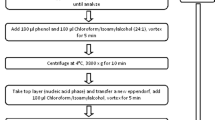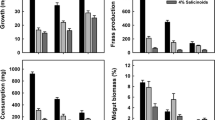Summary
Survival and body composition of starving gypsy moth larvae initially reared on aspen foliage or artificial diet differeing in nitrogen (N) and carbohydrate concentration were examined under laboratory conditions. Diet nitrogen concentration strongly affected starvation resistance and body composition, but diet carbohydrate content had no effects on these. Within any single diet treatment, greater body mass afforded greater resistance to starvation. However, starving larvae reared on 1.5% N diet survived nearly three days longer than larvae reared on 3.5% N diet. Larvae reared on artificial diet survived longer than larvae reared on aspen. Differences in survival of larvae reared on artificial diet with low and high nitrogen concentrations could not be attributed to variation in respiration rates, but were associated with differences in body composition. Although percentage lipid in larvae was unaffected by diet nitrogen concentration, larvae reared on 1.5% N diet had a higher percentage carbohydrate and lower percentage protein in their bodies prior to starvation than larvae reared on 3.5% N diet. Hence, larger energy reserves of larvae reared on low nitrogen diet may have contributed to their greater starvation resistance. Whereas survival under food stress was lower for larvae reared on high N diets, growth rates and pupal weights were higher, suggesting a tradeoff between rapid growth and survival. Larger body size does not necessarily reflect larger energy reserves, and, in fact, larger body size accured via greater protein accumulation may be at the expense of energy reserves. Large, fast-growing larvae may be more fit when food is abundant, but this advantage may be severely diminished under food stress. The potential ecological and evolutionary implications of a growth/survival tradeoff are discussed.
Similar content being viewed by others
References
Ayres MP, Suomela J, MacLean SF Jr (1987) Growth performance of Epirrita autumnata (Lepidoptera: Geometridae) on mountain birch: trees, broods, and tree x brood interactions. Oecologia 74:450–457
Capinera JL, Barbosa P (1976) Dispersal of first-instar gypsy moth larvae in relation to population quality. Oecologia 26:53–64
Chapman RF (1982) The insects: structure and function, 3rd ed. Harvard Univ Press, Cambridge
Clausen TP, Reichardt PB, Bryant JP, Werner RA, Post K, Frisby K (1989) Chemical model for short-term induction in quaking aspen (Populus tremuloides) foliage against herbivores. J Chem Ecol 15:2335–2346
Cymborowski B, Mieczyslawa B, Beckage NE, Williams CM, Riddiford LM (1982) Juvenile hormone titres and metabolism during starvation-induced supernumerary larval moulting of the tobacco hornworm, Manduca sexta L. J Insect Physiol 28:129–135
Dahlman DL (1973) Starvation of the tobacco hornworm, Manduca sexta. 1. Changes in hemolymph characteristics of 5th-stage larvae. Ann Ent Soc Am 66:1023–1029
DeGroff BJ (1969) The influence of egg mass size on populations of the gypsy moth, Porthetria dispar (L.) (Lepidoptera: Lymantriidae). Unpub MS Thesis, State Univ NY, College of Forestry, Syracuse
Duke JA, Atchley AA (1986) Handbook of proximate analysis tables of higher plants. CRC Press, Boca Raton
Fast PG (1964) Insect lipids: a review. Mem Ent Soc Can 37:1–50
Gerber GH (1984) Effects of starvation in the first instar larvae on growth, development and survival in the red turnip beetle, Entomoscelis americana (Coleoptera: Chrysomelidae). Can Ent 116:529–536
Gnaiger E, Bitterlich G (1984) Proximate biochemical composition and caloric content calculated from elemental CHN analysis: a stoichiometric concept. Oecologia 62:289–298
Goulden CE, Hornig LL (1980) Population oscillations and energy reserves in planktonic CLadocera and their consequences to competition. Proc Nat Acad Sci 77:1716–1720
Haukioja E (1990) Induction of defenses in trees. Ann Rev Entomol 36:25–42
Haukioja E, Neuvonen S, Hanhimäki S, Niemelä P (1987) The autumnal moth in Fennoscandia. In: Berryman AA (ed) Dynamics of forest insect populations: patterns, causes, and management strategies. Plenum Press, New York
Hill L, Goldsworthy GJ (1970) The utilization of reserves during starvation of larvae of the migratory locust. Comp Biochem Physiol 36:61–70
Iwao S (1959) Phase variation in the armyworm, Leucania unipuncta Haeworth. IV. Phase difference in the range of food tolerance of the final instar larva. Jap J Appl Entomol and Zool 3:164–171
Iwao S (1962) Studies on the phase variation and related phenomena in some lepidopterous insects. Mem Coll Agric Kyoto Univ 84:1–80
Iwao S (1967) Resistance to starvation of pale and black larvae of the armyworm, Leucania separata Walker (Lepidoptera: Noctuidae). Botyu-Kagaku 32:44–46
Jaenike J (1985) Genetic and environmental determinants of food preference in Drosophila tripunctata. Evolution 39:362–369
Jalees S, Murad H (1974) Effect of starvation on the oxygen consumption in Laccotrephes maculatus Fabr. (Hemiptera: Nepidae). Indian J Ent 36:287–289
Karowe DN, Martin MM (1989) The effects of quantity and quality of diet nitrogen on the growth, efficiency of food utilization, nitrogen budget, and metabolic rate of fifth-instar Spodoptera eridania larvae (Lepidoptera: Noctuidae). J Insect Physiol 35:699–708
Kleiber M (1961) The fire of life: an introduction to animal energetics. Wiley, New York
Kopec S (1924) Studies on the influence of inanition on the development and the duration of life in insects. Biol Bull 46:1–21
Leonard DE (1970) Effects of starvation on behavior, number of larval instars, and developmental rate of Porthetria dispar. J Insect Physiol 16:25–31
Lii GY, Garlich JD, Rock GC (1975) Protein and energy utilization by the insect, Argyrotaenia velutinana (Walker), fed diets containing graded levels of an amino acid mixture. Comp Biochem Physiol 52A:615–618
Lindroth RL, Hsia MTS, Scriber JM (1987) Characterization of phenolic glycosides from quaking aspen. Biochem Syst Ecol 15:677–680
Lohr P, Gade G (1983) Carbohydrate metabolism in the stick insect, Carausius morosus. J Insect Physiol 29:287–293
Milstead JE (1967) Changes in weight and hemolymph total solids resulting from starvation in the sixth instar of Peridroma saucia and Pseudaletia unipuncta (Lepidoptera: Noctuidae). J Invert Pathol 10:306–312
Mwangi RW, Goldsworthy GJ (1977) Interrelationships between haemolymph lipid and carbohydrate during starvation in Locusta. J Insect Physiol 23:1275–1280
Ng D (1988) A novel level of interactions in plant-insect systems. Nature 334:611–613
Odell TM, Butt CA, Bridgeforth AW (1985) Lymantria dispar. In: Singh P, Moore RF (eds) Handbook of insect rearing, vol 2. Elsevier, New York
Pearl R, Parker SL (1924) Experimental studies on the duration of life. X. The duration of life of Drosophila melanogaster in the complete absence of food. Am Nat 58:193–218
Peters RH (1983) The ecological implications of body size. Cambridge Univ Press, New York
Rausher MD (1984) Tradeoffs in performance on different hosts: evidence from within- and between-site variation in the beetle Deloyala guttata. Evolution 38:582–595
Rossiter MC (1987) Genetic and phenotypic variation in diet breadth in a generalist herbivore. Evol Ecol 1:272–282
Saleem MA, Shakoori AR (1985) Starvation and refeeding in Tribolium castaneum (Herbst). I. Effect on some biochemical components of sixth instar larvae. Can J Zool 64:1628–1632
Schroeder LA (1976) Effect of food deprivation on the efficiency of utilization of dry matter, energy, and nitrogen by larvae of the cherry scallop moth Calocalpe undulata. Ann Ent Soc Am 69:55–58
Siegert KJ (1987) Carbohydrate metabolism in starved fifth instar larvae of Manduca sexta. Arch Insect Biochem Physiol 4:151–160
Siegert KJ (1988) Hormonal regulation of fat body glycogen phosphorylase activity in larval Manduca sexta during starvation. Gen Compar Endocr 71:205–211
Siegert K, Ziegler R (1983) A hormone from the corpora cardiaca controls fat body glycogen phosphorylase during starvation in tobacco hornworm larvae. Nature 301:526–527
Singhal RN, Vats LK (1976) Effect of starvation on food consumption, assimilation, respiration and ecological efficiencies in adult Poecilocerus pictus Fabr. Indian J Ent 38:351–356
Tabashnik BE, Wheelock H, Rainbolt JD, Watt WB (1981) Individual variation in oviposition preference in the butterfly, Colias eurytheme. Oecologia 50:225–230
Threlkeld ST (1976) Starvation and the size structure of zooplankton communities. Freshwater Biol 6:489–496
Woodring JP (1984) The effects of starving versus fasting on blood composition in larval house crickets. J Insect Physiol 30:251–255
Author information
Authors and Affiliations
Rights and permissions
About this article
Cite this article
Stockhoff, B.A. Starvation resistance of gypsy moth, Lymantria dispar (L.) (Lepidoptera: Lymantriidae): tradeoffs among growth, body size, and survival. Oecologia 88, 422–429 (1991). https://doi.org/10.1007/BF00317588
Received:
Accepted:
Issue Date:
DOI: https://doi.org/10.1007/BF00317588




